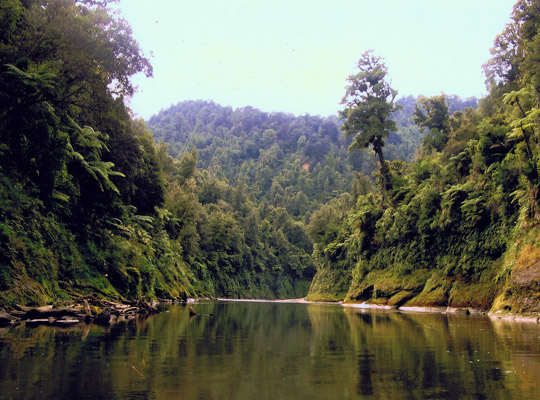Indian Country could finally see an end to nonconsented infrastructure projects if they follow New Zealand’s Maori in achieving legal protection for natural entities.
By Kayla DeVault. Published 9-12-2017 by YES! Magazine

The Whanganui River, New Zealand. Photo: Pinterest
In mid-March of this year, New Zealand officially recognized the Whanganui River as a living entity with rights. The river, which the Maori consider their ancestor, is now offered protection through the New Zealand legal system against any human or human-led project that threatens its well-being. It is a critical precedent for acknowledging the Rights of Nature in legal systems around the world.
The communities seeking protection for their natural entities through this approach are operating from a non-Western, often indigenous paradigm that holds a spiritual reverence to homelands and natural systems and an urgency to protect their natural resources. These values are not held in the laws of colonial governments like New Zealand, Australia, Canada, or the United States. But that does not mean they cease to exist, and, in fact, we are seeing a revival.
In response to the Standing Rock Sioux battle against the Dakota Access pipeline, the Ho-Chunk Nation of Wisconsin amended its constitution to include the Rights of Nature. This is the first time a North American tribe has used a Western legal framework to adopt such laws. Some American municipalities have protected their watersheds against fracking by invoking Rights of Nature.
Operating from a Lakota paradigm, the oil pipeline damage to Standing Rock sacred sites and threats to the Missouri River are an infringement on spiritual connection. Consider the irony of a Western paradigm that gives corporations the rights of people while government agencies give insufficient protection to the actual people affected. What if these waters—connected to the Creation Stories of the Lakota communities—were given legal personhood?
Here’s how New Zealand did it. After more than a century of legal battle, the Maori Iwi secured protection by forcing the New Zealand Crown to honor their practices, beliefs, and connection to the Whanganui River. As a result of the Te Awa Tupua Bill (Whanganui River Claims Settlement), the river has the legal rights of a person and is represented by two individuals. In passing this legislation, the New Zealand Crown also committed to protecting the customary practices of the Iwi regarding the river, and offered apologies and financial redress for historical wrongdoing.
If the Te Awa Tupua was able to correct the gap in Western and indigenous paradigms in New Zealand, surely a similar effort to protect the Missouri River could be produced for the Standing Rock and Cheyenne River nations by the American government.
How would that work? After defining the Missouri’s personhood, the collection of nations that hold cultural connection to and physical reliance on the river would next agree on the values that would govern its treatment. Under a joint agreement with the federal government, legal representatives for the river’s personhood would be appointed.
If the Missouri River had this kind of status, the Dakota Access pipeline would become a much different battle. Construction of the pipeline would first have to be approved by the river. Physical injury to the river could result in a lawsuit. Altering or confining the free-flowing nature of the river could be considered trauma. In combination with the risk of future chemical spills, these harms to the river should be enough to halt any Army Corps of Engineers permitting. Any negotiation would require legitimate consultation and consent from the river’s representatives. Consent might require royalties paid by Energy Transfer corporations to the river’s account. This account could be used to compensate those harmed by the river’s floodwaters and other natural disasters.
The Navajo still defend assaults on surrounding waters. The Winnemem Wintu work to recover the salmon that the Shasta Dam destroyed. And what about the mountains? The Gila River Indian Community and other O’otham groups continue decades of opposition against the Arizona state Route 202 extension that would cut through South Mountain, a sacred place to the people who have inhabited the Phoenix area since the beginning of their times. As construction begins this summer, many are scrambling to prevent irreversible destruction to the mountain and, by extension, the culture.
Should more tribes follow the path of the Ho-Chunk Nation, we may finally see an end to nonconsented infrastructure projects in Indian Country.

Kayla DeVault wrote this article for Just Transition, the Fall 2017 issue of YES! Magazine. Kayla is an Anishinaabe and enrolled Shawnee, living on the Navajo reservation. She currently works as a research assistant/engineer. She is pursuing an A.A. in Diné studies and a master’s in American Indian studies before starting a Ph.D. program in tribal energy policy.
This article is republished under a Creative Commons Attribution-NonCommercial-NoDerivatives 4.0 International license

